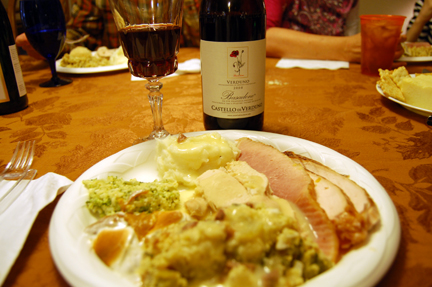
Above: The cuttlefish crudo at Marea.
There are many in our field who claim to be the world’s greatest experts on Italian wine. You certainly don’t need me to tell you who they are: they have publicists for that!
To my mind, Antonio Galloni is the greatest English-language authority on Italian wine in the U.S. today.
That’s not to say that there aren’t plenty of others important writers to whom we need to listen. But the clarity and purpose of Antonio’s voice and the aequitas of his approach make him stand out among the field of the merely so-called as well as the bona fide Italian wine experts.

Above: Sommelier Francesco Grosso’s list features a lot of the usual suspects (and you don’t need to tell you who they are) but it also includes many gems for the Italian wine geeks among us, like this Blanc de Morgex et La Salle by Pavese.
Antonio was leaving the next day for Italy and the list of producers he is visiting… well, it would make you drool, too.
I cannot conceal that I was thrilled to get to meet him and to talk shop. We discussed Bartolo Mascarello, Beppe Rinaldi, Gianfranco Soldera, Angelo Gaja, and many others, and his insights are always fascinating to me (whether delivered via the Wine Advocate these days or a voce, in this case).
I followed his excellent newsletter Piedmont Report since its early days in 2004 (the original Italian wine blogger ante litteram?) and I think his knowledge and experience in Piedmont in particular are remarkable. His vintage notes are especially vital to our field.
“Every element of traditional winemaking in Barolo is present in Beppe Rinaldi,” he said making reference to the winemaker he goes back to every year and one of his favorites. This was just one of the gems that I took away with me that day. Man, I’d love to taste those wines with him.

Above: The spaghetti were excellent, although the crab and sea urchin sauce was a little too spicy.
I learned that his parents owned a wine store in Florida when he was growing up. I discovered that he’s a jazzer (studied at Berkeley) and a opera tenor (studied in Milan).
But the coolest thing was to learn that this dude, however revered and feared he is by nearly every Italian winemaker and wine publicist in the world today, is a really mellow guy who just digs Italy, Italian wine, and Italian food.
It can’t be easy to work with and for “Bob Parker” and to manage all the pressure and scrutiny that come along with the gig. But somehow Antonio seems to never have lost site of his original mission. He just loves Italian wine. (He speaks Italian with native speaker proficiency, btw.)
The power of the wine press may be excessive at times. But thank goodness that there are folks like him who somehow (miraculously, really) manage to balance the yin and the yang of it all.
Whether tasting with Gaja (yin?) or Rinaldi (yang?), Antonio put it best: “I’ll just never get tired of traveling to Italy,” he said, “and tasting wine and eating great food.”
Ubi major, minor cessat.


























